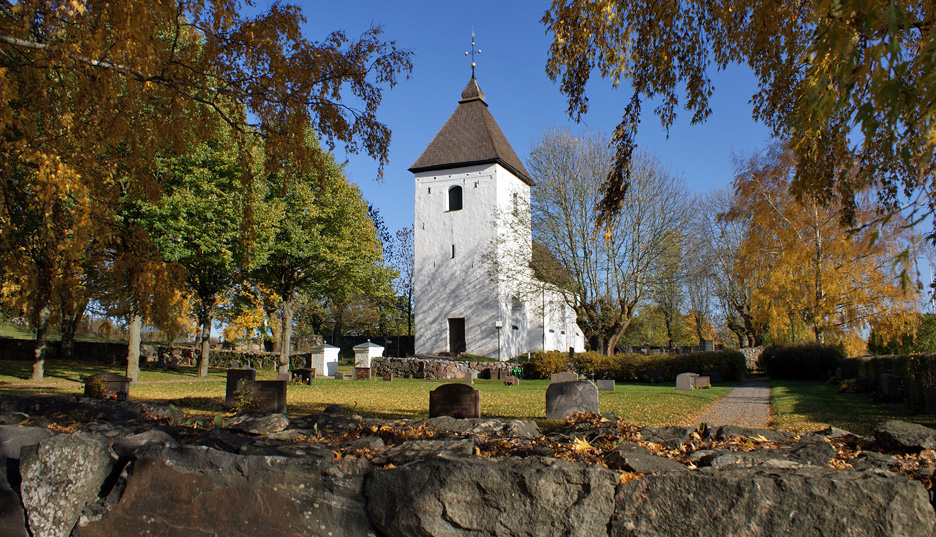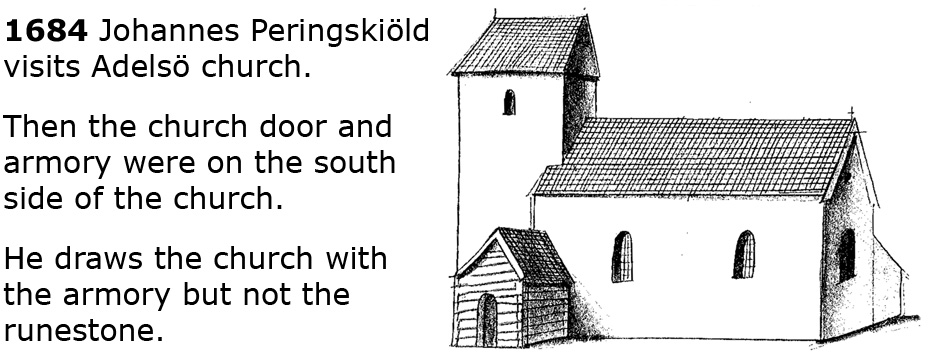
History & runes
Early 17th century and the
antiquarian Johannes Bureus comes to Adelsö and finds the
runestone U 2 as a threshold stone to Adelsö church and
notes: "for the church door".
Bureu's great passion was runes and runic
inscriptions so he carefully draws these but unfortunately
not the ornamentation of the rune stone which was probably
too difficult to interpret because it was so badly worn.

J. Bureu's note on rune stone U 2 early
17th century.
Runic inscription:

English
Ofeigr and …-bjorn, they had these
stones raised in memory of Ernbjorn, their father. May God
help his soul.
Thanks to the shape and spelling of the runes, the runestone
can be linked to the rune carver Balle, active at the end of
the 11th century and disciple of the master Livsten.
Balle can be attributed to
about 40 runestones in both Uppland, Södermanland and
Västmanland, of which about 20 are signed with the name
"bali".
History
(1610-1630)
Sometime during the first part of the 17th century, the rune
stone is removed as a threshold stone and placed in the
armory and the church entrance.
(1650-1670)
The armory is on fire!
When the armory later burns, the runestone is charred and
broken.
1679
There is a preserved note that Erich Jöransson and Anders
Bengtsson were paid in 1679 for rebuilding the armory.

Drawing: J. Peringskiöld ca 1684
Peringskiöld's description of the runestone:
"... outside the door
of the armory, on a large lying slab of
reddish stone, but now by the last fire in the wooden
armory, so burnt and broken in pieces that you can
hardly see any runic inscription on it now..."
Here are some interesting details…
It is found in 1684 outside the armory's
door. It is a large
rune stone which, after the fire in the armory, broke into
pieces and was then placed outside the armory.
The rune stone is red and is worn after years
of trampling as a threshold stone into the church. Then it
is definitely red sandstone just like U 1 and U 3.
Peringskiöld also writes:
".. almost none of the carving is visible anymore .." "almost"
but then in any case there is something left, and if you
were to find parts today, with the help of lighting from the
side you should still find part of the work.
So where are the (large) burnt pieces of red
sandstone now? Either
they are in the old wall or they have been used for filling
or similar. If the pieces were still big enough, they might
have been reused, for example. headstone.
Links
Upplands runinskrifter > page
4
Only in Swedish
Runcarver Balle och U 2 > PDF
Only in Swedish
Runor > Riksantikvarieämbetet
Map and runic inscription.
Google
map >
Find the runestone
kalle@runristare.se
If you want to be of help or have a question.
ALL
RUNESTONES
Ekerö
municipality
ADELSÖ >
has 5
known runestones
BIRKA >
has fragments from 9 known
runestones
MUNSÖ >
has 3 or
4 known runestones
EKERÖ >
has 11 known runestones
FÄRINGSÖ
>
has 27 known runestones
LOVÖ >
has 8 known runestones
|

